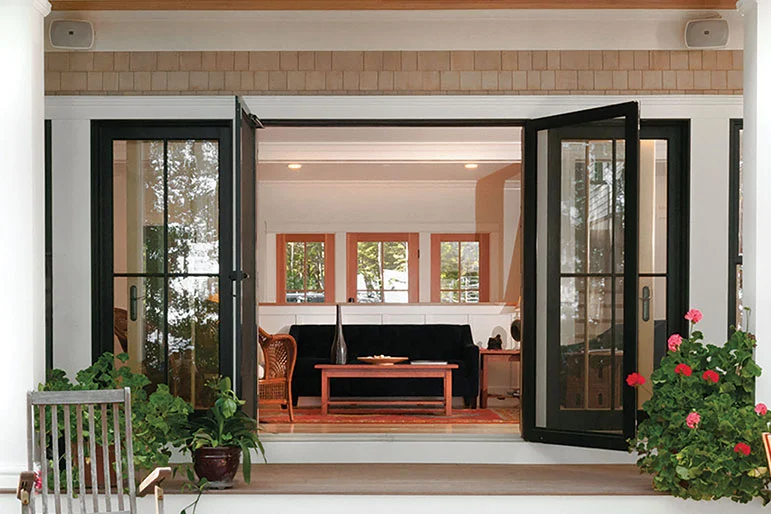Upgrading your home with a new patio door can completely change how you live—bringing in natural light, improving energy efficiency, and boosting curb appeal. Home Depot offers a wide range of patio doors, from simple sliding glass panels to timeless French doors. In this friendly guide, we’ll walk through all the options you’ll find at Home Depot, highlight top brands, compare key features side-by-side, and share practical tips for choosing and installing the perfect door. We’ve also included a short FAQ and links to reliable resources so you can double-check details.
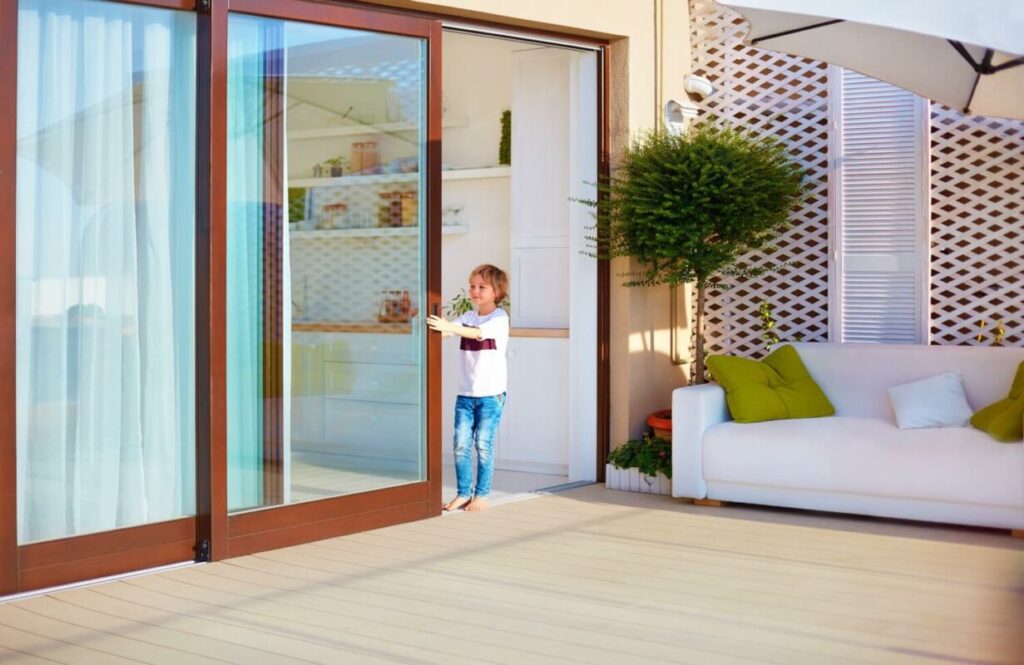
1. Patio Door Styles You’ll See at Home Depot
Home Depot carries several patio door styles to fit different budgets, home layouts, and design tastes. Here are the most popular:
Sliding Glass Doors
- What They Are: One stationary glass panel plus one (or more) panels that glide horizontally on a track.
- Why You Might Pick Them: They’re space-saving (no door swing), easy to open, and offer a large, unobstructed view.
- Where They Work Best: Living rooms, family rooms, or kitchens that open onto a deck or patio.
- Example at Home Depot: Sliding Patio Doors
French Doors
- What They Are: A pair of hinged doors that swing in or out from the center. They often come with sidelights (narrow windows on either side) for extra brightness.
- Why You Might Pick Them: Their classic look works beautifully in traditional or colonial-style homes, and they provide a wider opening for fresh air.
- Where They Work Best: Formal dining rooms, master bedrooms, or any room where you want an expansive, elegant entrance to the outdoors.
- Example at Home Depot: French Patio Doors
Bi-Fold Doors
- What They Are: Multiple narrow panels that fold against one another in an accordion-like fashion.
- Why You Might Pick Them: They create a nearly seamless transition between inside and outside, opening up the entire wall.
- Where They Work Best: Entertainment spaces, kitchens that flow to a patio, or sunrooms where you want a true indoor-outdoor feel.
- Example at Home Depot: Bi-Fold Patio Doors
Hinged (Swing) Doors
- What They Are: A single door or a pair of doors hinged on one side that swing open and closed.
- Why You Might Pick Them: Ideal for smaller openings or side-yard access, these doors seal tightly and look more like a traditional entry door.
- Where They Work Best: Eating nooks, bathrooms opening onto a deck, or any spot where a sliding track isn’t practical.
- Example at Home Depot: Hinged Patio Doors (Note: Hinged French doors double as swing patio doors.)
Stacking Sliding Doors
- What They Are: Multiple sliding panels that stack one behind another when opened, giving you a wider view than a standard two-panel slider.
- Why You Might Pick Them: They maximize glass area—no center post—so you get an almost panoramic, unobstructed view.
- Where They Work Best: Large living rooms, dining areas, or any room where you want the “wall of glass” effect.
- Example at Home Depot: Stacking Sliding Patio Doors
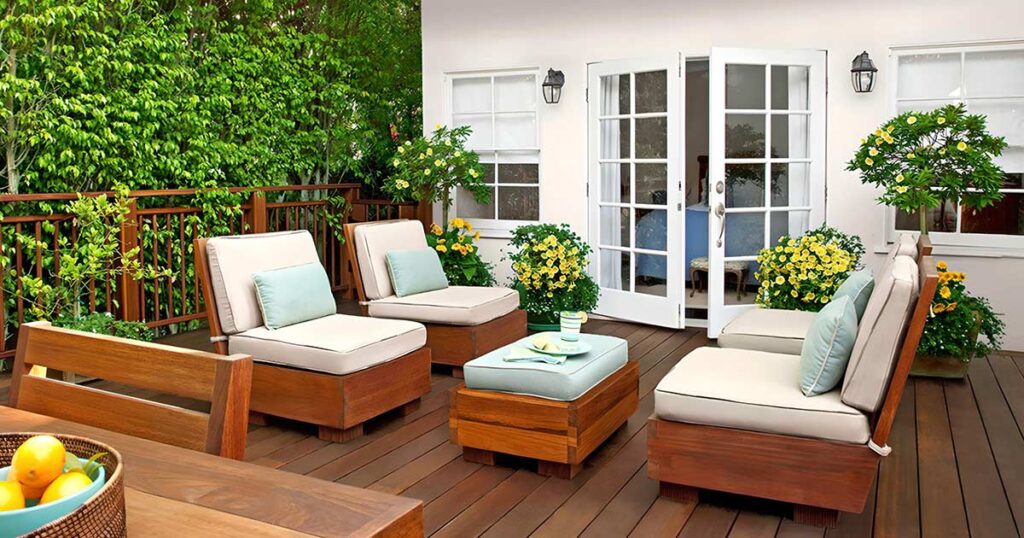
2. Top Patio Door Brands You’ll Find at Home Depot
Home Depot carries patio doors from several well-known manufacturers. Each brand has its own strengths—whether you’re after budget-friendly pricing, energy efficiency, or a premium look.
Masonite
- About Them: Around since 1925, Masonite is known for sturdy fiberglass and steel patio doors.
- Why You’ll Like Them: Their frames are thick, well-insulated, and you can customize finishes to match your home’s style.
- Learn More: Masonite’s Official Site
Pella
- About Them: Founded in 1925, Pella makes both vinyl and fiberglass patio doors.
- Why You’ll Like Them: They offer between-the-glass blinds (Insynctive®) for privacy plus high-performance glass packages that boost energy savings.
- Learn More: Pella’s Patio Door Collection
JELD-WEN
- About Them: Since 1960, JELD-WEN has offered budget-friendly options under their “Atrium” and “Soft-Lite” vinyl lines.
- Why You’ll Like Them: You’ll find ENERGY STAR®–certified models that won’t break the bank.
- Learn More: JELD-WEN Patio Doors
Milgard
- About Them: Milgard has been making windows and doors since 1958. They started on the West Coast but now serve homeowners everywhere.
- Why You’ll Like Them: Their SunCoat® Low-E glass blocks UV rays and helps keep your home comfortable.
- Learn More: Milgard Patio Doors
Andersen (Renewal by Andersen)
- About Them: A family-owned company since 1903, Andersen’s replacement division has been around since 1995.
- Why You’ll Like Them: Their fiberglass and composite frames are top-tier, and they offer custom sizes and premium finishes—though they come with a higher price tag.
- Learn More: Andersen Patio Doors
3. Comparing Key Features Side-by-Side
To help you narrow down your options, here’s a quick chart showing how the main patio door styles stack up. All U-Factor and SHGC (Solar Heat Gain Coefficient) values assume double-pane, Low-E glass with argon fill. Always double-check the exact ratings for any model you’re interested in—especially since Home Depot sometimes runs special bundles or local promotions.
| Door Style | Common Frame Materials | U-Factor Range<br>(Lower = Better Insulation) | SHGC Range<br>(Lower = Less Heat Gain) | Price Range* | Typical Warranty | Ideal For |
|---|---|---|---|---|---|---|
| Sliding Glass | Vinyl / Aluminum | 0.30 – 0.35 | 0.25 – 0.30 | $800 – $2,500 | 10 – 20 years (frame & glass) | Standard-sized openings, tight spaces |
| French | Fiberglass / Wood | 0.28 – 0.33 | 0.20 – 0.28 | $1,200 – $3,500 | 20 – 25 years (frame & glass) | Traditional style, wide openings |
| Bi-Fold | Aluminum / Vinyl | 0.35 – 0.40 | 0.30 – 0.35 | $2,000 – $6,000 | 10 – 20 years | Large, open-concept spaces for indoor-outdoor flow |
| Hinged (Swing) | Fiberglass / Steel | 0.28 – 0.32 | 0.22 – 0.30 | $900 – $2,800 | 20 – 25 years (frame & glass) | Smaller openings, easy to seal tightly |
| Stacking Sliding | Vinyl / Aluminum | 0.29 – 0.34 | 0.24 – 0.30 | $1,500 – $4,000 | 10 – 20 years | Panoramic views, modern homes |
* Prices will vary based on door size, custom features, and local installation costs. Always ask for a written quote before committing.
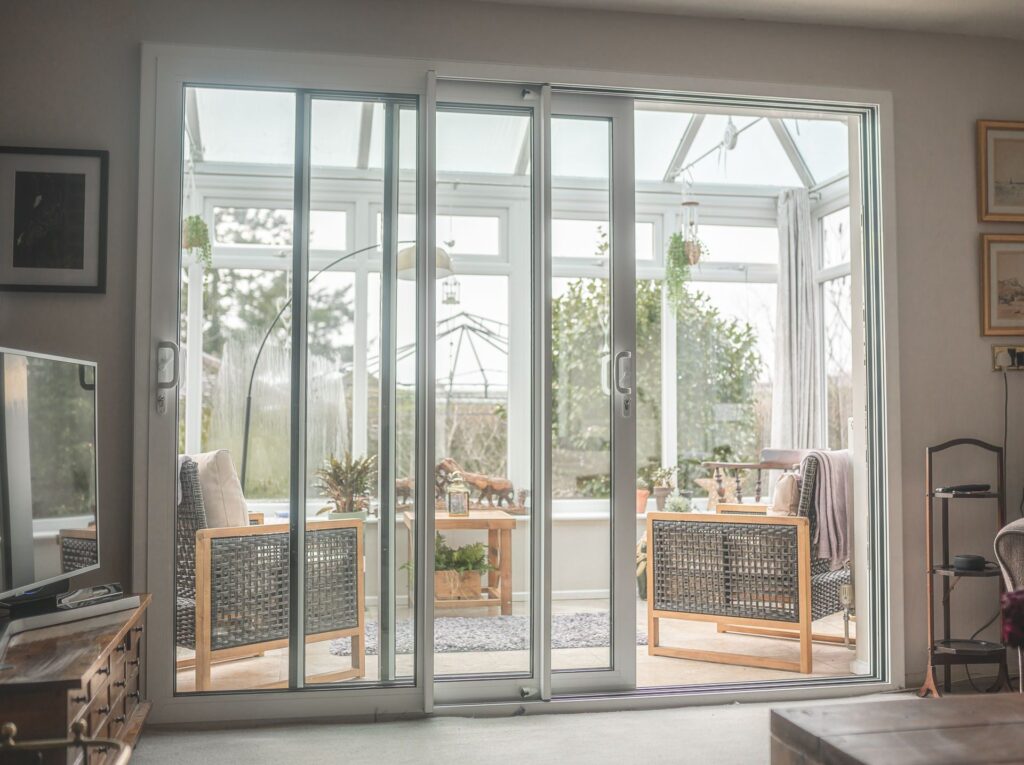
4. Tips for Picking and Installing Your Patio Door
- Match the Door Style to Your Home’s Look
- Sliding Doors: Neat and contemporary—great for ranch-style or modern homes.
- French Doors: Timeless elegance—perfect for colonial, farmhouse, or traditional designs.
- Bi-Folds: Ultra-modern, best for entertainers who want an all-in-one indoor-outdoor party space.
- Hinged Doors: Classic single or double swings work well for smaller nooks or areas where a track won’t fit.
- Stacking Sliders: For an ultra-wide view—ideal in living rooms that back up to scenic views.
- Think About Energy Efficiency
- Look for the ENERGY STAR® label and be sure to select a door that’s rated for your climate zone.
- In northern areas (cold winters), prioritize a low U-Factor (below 0.30). In hot, sunny regions, focus on a low SHGC (below 0.30) to reduce cooling costs.
- Security and Hardware Matter
- Many Pella, Milgard, and Andersen doors include multi-point locking systems that latch in several spots for extra security.
- If you live in a hurricane-prone or high-wind region, ask about impact-resistant or tempered glass options.
- Measure Accurately
- Always measure the rough opening—width, height, and frame depth—three times and use the smallest number for each.
- Decide if you need an insert/retrofit door (fits into the existing frame) or a full-frame replacement (removes the old door frame and trim).
- Consider Professional Installation
- Home Depot partners with licensed installers who know how to flash, weatherproof, and seal correctly. Proper installation is crucial to avoid leaks or drafts down the road.
- Ask installers if they’re certified by the brand you’ve chosen—some warranties require professional installation to stay valid.
- Plan for Extras and Maintenance
- Installation Costs: Generally range from $300 to $800 per door, depending on complexity and local rates.
- Add-Ons: Built-in blinds, screens, special grid patterns, or custom hardware will increase your price.
- Upkeep: Keep tracks clean, inspect weatherstripping each season, and lubricate rollers or hinges with a silicone-based spray once a year.
5. FAQ
Q: How much does a patio door cost when installed through Home Depot?
A: For a standard 80″ × 80″ vinyl sliding patio door, you’re looking at roughly $800–$1,200 for the door itself, plus $300–$800 for professional installation. Upgrading to fiberglass or wood-clad doors can push the total closer to $1,500–$3,500 after labor.
Q: What’s the difference between a retrofit insert and a full-frame patio door?
- Retrofit/Insert: Drops into your existing jamb—keeps your current trim and siding intact. Faster, less mess, lower labor cost. Requires that your old frame is square, level, and undamaged.
- Full-Frame: You remove the entire old door, frame, and trim. Gives you a fresh start (ideal if your framing is rotted or you want to change size or style). More labor-intensive and usually costs more up front.
Q: Are Home Depot’s patio doors ENERGY STAR® certified?
A: Yes—many doors from brands like Pella, Milgard, and Andersen carry the ENERGY STAR® label for most U.S. climate zones. Always double-check the product details or ask a sales associate to confirm the U-Factor and SHGC ratings for the exact model you’re considering.
Q: How do I maintain my patio door for smooth operation?
- Clean the tracks every month: Vacuum out debris and wipe down with a damp cloth.
- Lubricate rollers and hinges once a year with a silicone-based spray—no WD-40, which can attract dust.
- Inspect weatherstripping each season—if it looks cracked or flattened, replace it to keep drafts out.
- Wash the glass with a non-abrasive cleaner and a soft cloth to avoid scratches.
Q: Do I need a permit to replace my patio door?
A: It depends on your local building codes. Generally, if you’re doing a like-for-like swap (no changes to the rough opening or structural framing), you probably won’t need a permit. But if you’re enlarging the opening, adding structural headers, or altering a load-bearing wall, you’ll almost certainly need a permit. Always check with your city or county building department first.
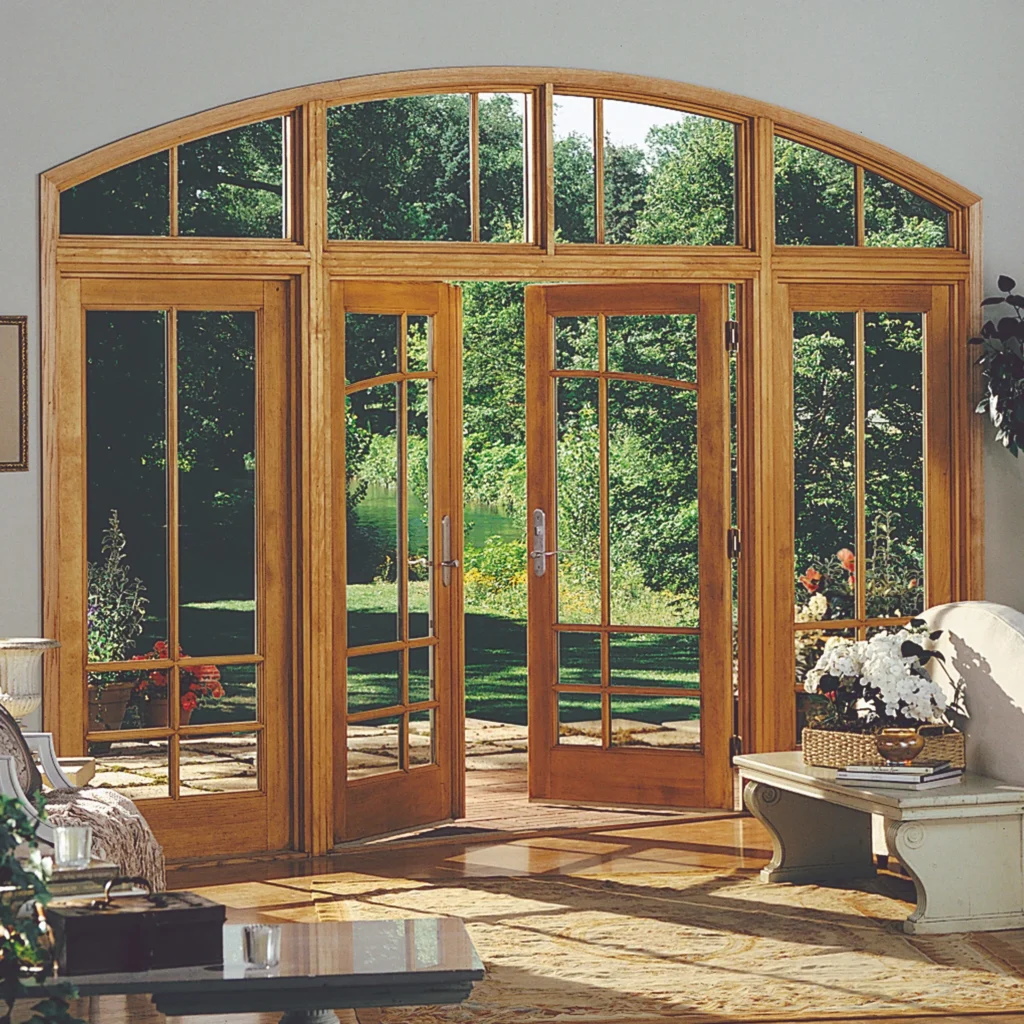
6. Authoritative Resources
- Home Depot Sliding Patio Doors
https://www.homedepot.com/b/Doors-Windows-Exterior-Doors-Sliding-Patio-Doors/N-5yc1vZc3nv - Home Depot French Patio Doors
https://www.homedepot.com/b/Doors-Windows-Exterior-Doors-French-Doors/N-5yc1vZc1pd - ENERGY STAR® – Windows, Doors, & Skylights
https://www.energystar.gov/products/residential_windows_doors_and_skylights - Pella – Patio Doors
https://www.pella.com - Milgard – Patio Doors
https://www.milgard.com - Andersen – Patio Doors
https://www.andersenwindows.com - OSHA – Ladder Safety Guidelines (for high installations)
https://www.osha.gov/etools/construction/ladder-material-handling - IECC Code (Insulation & Performance Requirements)
https://codes.iccsafe.org/content/IECC2021P2
By understanding the patio door styles, brands, and features that Home Depot offers—and weighing things like energy efficiency, appearance, and installation—you’ll be ready to pick a door that fits your home and your budget. Use the tips above, check out the linked resources, and enjoy the fresh air (and light) a new patio door brings!

